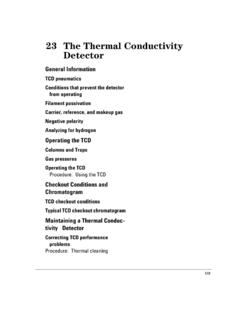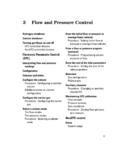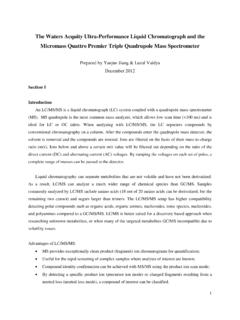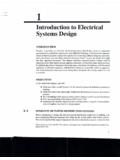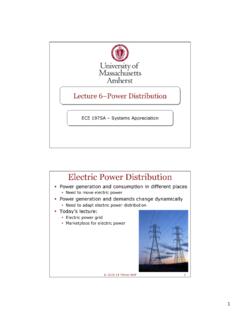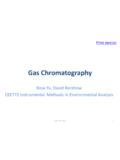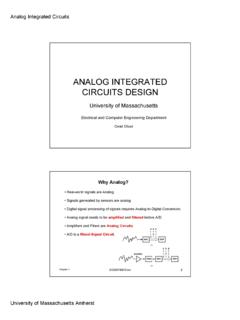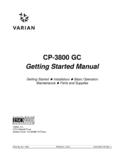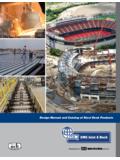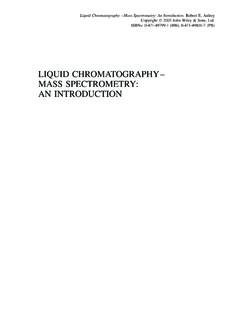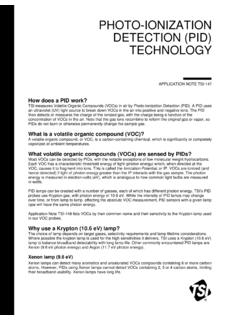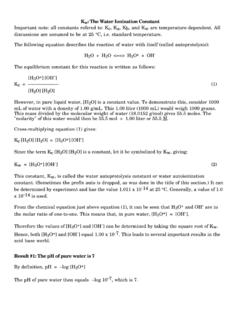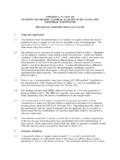Transcription of Fundamental LC-MS Introduction - UMass Amherst
1 Mass Spectrometry Fundamental LC-MS . Introduction Wherever you see this symbol, it is important to access the on-line course as there is interactive material that cannot be fully shown in this reference i manual. Aims and Objectives Aims and Objectives Aims Introduce Fundamental LC/MS concepts Explain the function of each major component of the LC/MS system Indicate the major advantages of LC/MS and the application areas in which it is used Objectives At the end of this Section you should be able to: Describe the function of the various elements that are present in a typical LC/MS. system List and explain the two main considerations common to all interface types List the most common interfaces and be able to clearly describe the differences between them List the most common mass analyzer types Content Definitions 3.
2 Instrument fundamentals 4. Process 5. Why and when to use LC/MS 6. HPLC separations 6. MS detection 6. MS detection 6. Ionisation 7. Overview 7. Atmospheric Pressure Ionisation (API) 8. Electrospray Ionisation 9. Atmospheric Pressure Chemical Ionisation (APCI) 10. Atmospheric Pressure Photo Ionisation (APPI) 11. Mass analysers 12. Quadrupole 13. Time-of-flight (TOF) 14. Ion Trap Mass Analyser 14. Tandem mass spectrometry (MS/MS) 16. Detectors 16. Point detectors 16. Array detectors 16. Applications 17. References 22. Crawford Scientific 2. Definitions LC/MS is a hyphenated technique, which combines the separating power of High Performance Liquid Chromatography (HPLC), with the detection power of mass spectrometry.
3 Mass Spectrometry is a wide-ranging analytical technique, which involves the production and subsequent separation and identification of charged species. The associated acronym, LCMS (Liquid Chromatography-Mass Spectrometry) covers a broad range of application areas. This module will explore the instrument acquisition methods used, and examine the type of data that can be produced from such systems. HPLC system LC/MS diagram For more information about HPLC you can refer to the HPLC Channel.[1]. Crawford Scientific 3. Instrument fundamentals The mass spectrometer is an instrument designed to separate gas phase ions according to their m/z (mass to charge ratio) value.
4 Mass spectrometry involves the separation of charged species which are produced by a variety of ionisation methods in LC-MS . These include: Electrospray Ionisation (EI). Atmospheric Pressure Chemical Ionisation (APCI). In all cases the charged species are produced as gas phase ions under atmospheric pressure conditions. The separation of the gas phase ions is achieved within the mass spectrometer using electrical and/or magnetic fields to differentiate ions. In addition to the analyser, the mass spectrometer also includes an atmospheric ionisation chamber, a vacuum system and a detector.
5 1 2 3 4 5 6. 7. Main elements of an LC/MS equipment Crawford Scientific 4. Where: 1. Ion source: The HPLC eluent is sprayed into the atmospheric pressure region 2. Skimmer Cone: A cone with a sampling orifice of reduced diameter to preferentially sample gas phase ions and reduce the gas load entering the vacuum system of the mass analyser device. 3, Quadrupole: Device that uses electric fields in order to separate ions according tot their mass to charge ratio (m/z) as they pass along the central axis of four parallel equidistant rods. Cell: Ions emerging from the first mass analyser are accelerated using a potential difference and collide with neutral gas molecules such as H2, N2 or Ar, causing analyte fragmentation.
6 6. Detector: Once produced and separated, the ions need to be detected and transformed into a usable signal. Electron multiplier, Dynode, Photodiode, and Multi Channel Plate (MCP) ion detection systems are widely employed in most modern mass spectrometer systems. 7. Vacuum system: Mass analysers require high levels of vacuum in order to operate in a predictable and efficient way. The vacuum systems of most modern LC-MS systems consist of two or more differentially pumped vacuum chambers, separated by baffles or orifice plates of varying design depending upon the instrument manufacturer.
7 Process There are several discrete stages in LC-MS analysis, typically these include: Separation of the sample components using an HPLC column where the analytes are differentially partition between the mobile phase (eluent) and the stationary phase (coated onto a support material and packed into the column). The mechanism of retention and separation will depend on the mode of chromatography but may include, Hydrophobic Interaction, Ion Exchange, Ion-Pair, Surface Localisation, etc. The separated sample species are then sprayed into an Atmospheric Pressure Ion Source (API) where they are converted to ions in the gas phase and the majority of the eluent is pumped to waste.
8 The mass analyser is used to sort ions according to their mass to charge ratio. Most popular analyser types include Quadrupole (shown opposite), Time of Flight, Ion Trap and Magnetic Sector. The mass analyser may be used to isolate ions of specific mass to charge ratio or to scan' over all ion m/z values present. The detector is used to count' the ions emergent from the mass analyser, and may also amplify the signal generated from each ion. Widely used detector types include: electron multiplier, dynode, photodiode and multi-channel plate. All mass analysis and detection is carried out under high vacuum established using a combination of foreline (roughing) and turbomolecular pumps.
9 Crawford Scientific 5. i LC/MS system Why and when to use LC/MS. The use of LC-MS in many application areas within analytical science continues to grow almost exponentially. Listed below are some pointers as to the applicability of both HPLC. as a separative technique and MS as a means of detecting analyte species. HPLC separations For HPLC analysis the analyte must be soluble in the mobile phase HPLC can analyse samples over a wide polarity range including ionic samples HPLC has no real upper molecular weight limit and large proteins of many thousands of Daltons may be analysed. Solubility in the mobile phase may preclude the analysis of very large molecules.
10 The ESI LC/MS spectrum of the Locusta migratoria cuticular protein[2]. ( Da) is presented below HPLC samples are prepared in a solvent system that has the same or less organic solvent than the mobile phase and injection volumes of 1 to 50 l are common (1-10 g of analyte per 1g packing material). ESI LC/MS spectrum of Locusta migratoria cuticular protein ( Da). MS detection Allows specific compound identification (structural elucidation via spectral interpretation combined with elemental composition from accurate mass analysers is possible). Very sensitive (fempto-gram amounts have been detected by certain mass analyzer types).
